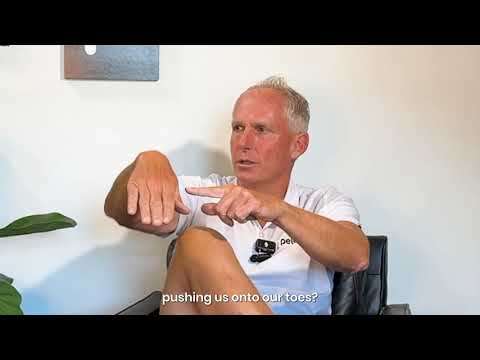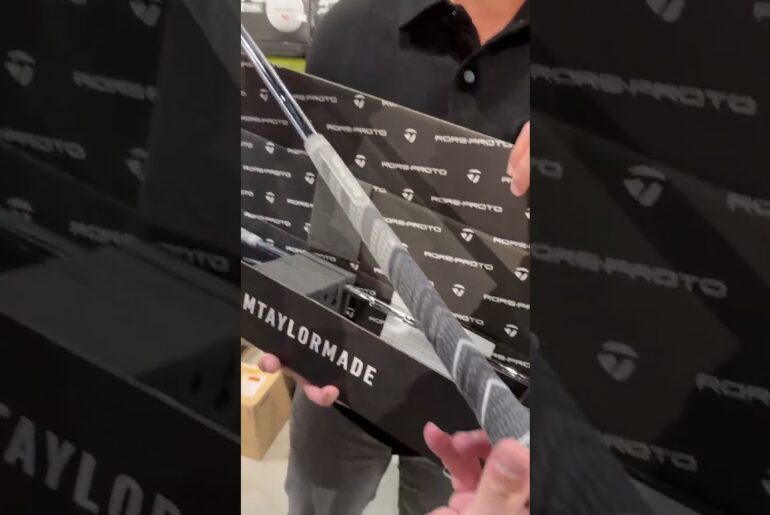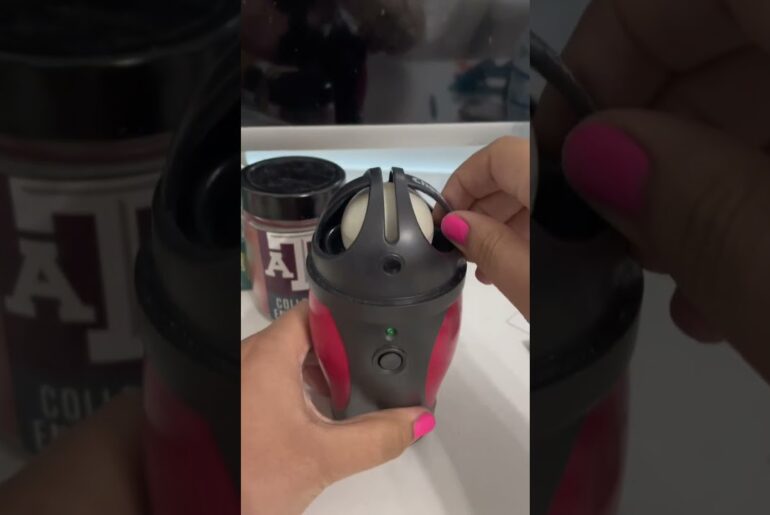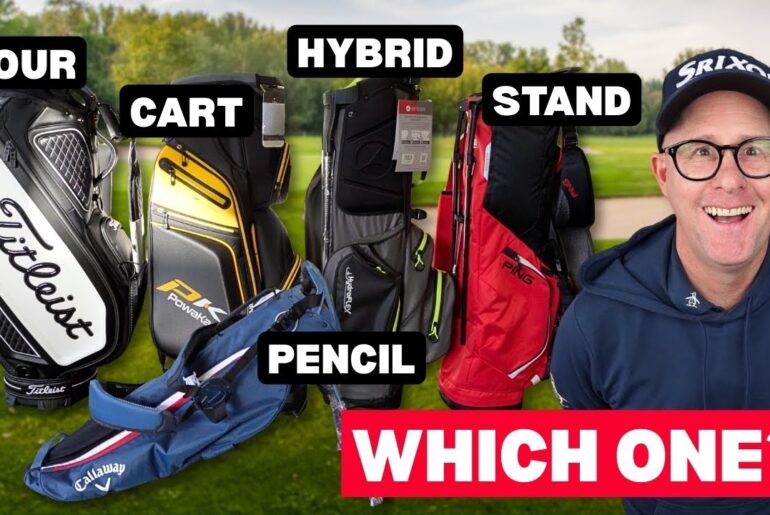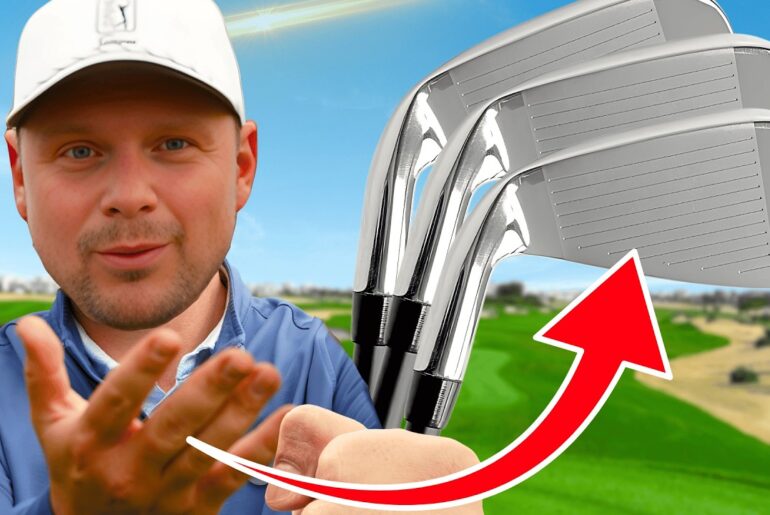Discover why the new Peluva Apollo Golf Shoe is changing the way golfers walk, swing, and play.
Peluva co-founder Kyle Sisson talks with Christopher Smith, top-50 PGA teaching professional and Guinness World Record Speedgolfer Christopher Smith about the R&D behind the Peluva Apollo and how it can improve your golf game – and your comfort walking the golf course!
Kyle and Christopher discuss:
✅ How the Apollo’s five-toe, zero-drop design enhances balance and groundfeel
✅ Why traditional golf shoes can actually disconnect you from your intricate movement patterns and weight transfer during the golf swing
✅ How the Apollo helps improve neuro-sensitivity and proprioception during the full swing, and can even improve your green reading!
✅ Real benefits noticed by elite and everyday golfers, including a much more comfortable walk!
The Peluva Apollo is engineered with:
◉ Full-grain perforated leather for breathability
◉ A spikeless high-density rubber-nub tread pattern for traction on greens and fairways
◉ A cutting edge midsole material known as “Super Critical EVA” for comfort and flexibility over varied terrain
◉ Barefoot-inspired “groundfeel” for better green reading and swing power
Whether you’re a competitive player or simply want to enjoy a comfortable walk on the course, the Apollo can transform your game and foot health.
____________________________
ABOUT PELUVA FOOTWEAR
“Let your feet be feet!” Peluva reimagines minimalist footwear with the most stylish, functional, and fashion-forward zero-drop five-toe minimalist shoe ever made. Reclaim your natural movement and build a stronger, healthier body with every step.
🦶 Shop now or learn more at https://peluva.com/
📘 Download our FREE e-book: The Definitive Guide to a Barefoot and Minimalist Shoe Lifestyle
🔔 Subscribe for stories, foot health tips, and movement inspiration: https://www.youtube.com/@UCcdKQmbO8kw0QOnc9L3wRQQ
CONNECT WITH US
Instagram: https://www.instagram.com/wearpeluva/ | https://www.instagram.com/marksissonprimal/ | https://www.instagram.com/bradkearns1/
Facebook: https://www.facebook.com/wearpeluva/
Facebook Group: https://www.facebook.com/groups/peluvacommunity
TikTok: https://www.tiktok.com/@wearpeluva
Email: info@peluva.com
#Peluva #WearPeluva #MinimalistShoes #BarefootShoes #FiveToeShoes #ZeroDropShoes #FootHealth #NaturalMovement #FunctionalFootwear #BarefootLifestyle #FitnessLifestyle #ActiveLifestyle #MilitaryDiscount #ApolloGolf #PeluvaGolf #PeluvaStrand
I’ve been a student and a player of the game for over 50 years and a full-time teacher and coach for the last three and a half decades. I think what’s interesting about the Paluba golf shoe is it’s basically how our feet are designed to function. I am a believer in metrics and in stats. So, here’s one. All of us on the planet that play golf, we take 75% of our shots from 60 yards and less. We know this. You guys have known this since day one. A lot of people are going to say, “I’m never going to wear that shoe cuz it looks funny.” Yeah.
Okay. Let’s go back a few years in golf. So, it wasn’t that long ago that everybody wore wool jackets and ties to play golf,
right? Hey, I’m Kyle Sison, co-founder of Paluva, and I’m here with Christopher Smith, a man of many talents. Christopher, let’s just start. Why don’t you give me a little bit of background about um you know, who you are, your journey, and potentially why we’re sitting here together.
Yeah, pleasure to be here with you. Well, I’ve been a student and a player of the game for over 50 years and a full-time teacher and coach for for the last three and a half decades. I’m a PJ master professional in teaching and coaching. I’m the director of instruction at Eugene Country Club in Eugene, Oregon at Puerto Los Cabos Golf Club in Baja, Mexico. Um, longtime uh afficionado of how important footwear is to golf performance. and so thrilled to to, you know, have discovered and uh be helping out with this, you know, with the PUVA version of of the golf shoe because it’s so important to to playing better golf and that’s what I’ve I’ve done for a living and it’s my passion and helping people play better. So,
that’s right. So, let’s talk a little bit about um you know, how we came across you. Obviously, with what you’ve mentioned, you are an expert in golf and golf instruction, right? So, um you know, golf is a huge passion of mine. And I’d say my favorite, my number one hobby. Yeah.
Um with Paluva, we set out recently, maybe almost about a year ago, we said Paluva, the concept behind it would make for a great golf shoe. So we started prototyping. And at that moment, we realized we need an expert on our side, right? Because I love golf. I love Paluba. I think I can get, you know, pretty far with uh a shoe that’s going to help me play golf. But we really felt like we needed someone who really knew the game, really knew the the mechanics of a golf swing and what goes into, you know, like you said, the importance of footwear in golf. So, at that point, um, we started to search the internet and, uh, we came across you as someone who, like you said, was a a PGA master golf coach and teacher. um and someone who understood all those things and uh you know we reached out to you and and luckily you had an interest. So let’s let’s talk a little bit about that interest because you know when we initially reached out you had a prior engagement with another company and you had been working on um footwear for speed. Tell me a little bit about your background in speed golf and what what speed is for those who don’t know about it. Yeah. So, speed golf’s basically it’s a it’s a it’s a niche sport within a niche sport. You know, people think golf is a niche sport. So, speed golf’s a wacky sport that I’ve played for the last 30 years or so where you actually run in between shots and then you keep your time and your score. So, if you shoot, for example, a score of 80 and 60 minutes, your total is 140. And I set the Guinness World Record in this niche sport back in 2005 where I shot 65 in 44 minutes.
Wow.
With just six clubs. And so it’s become a passion of mine, a hobby of mine. I’ve actually used some of the concepts from speed golf to help people in what I like to call slow golf, which is traditional golf, right?
We’re intuitively and instinctively and a little less deliberately really tapping into the to the human system, mind, body, brain, you can play better golf. And so, um, working on, you know, all different aspects performance. um you know when you’re running between shots obviously your footwear is important but then also when you’re you know the interesting thing is is when you’re playing normal golf y
you’re maybe out there for four and a half hours you’re walking anywhere from 3 to 5 miles and you’re spending most of your time walking and standing
right
and what I always found odd I still find odd is most golf shoes are not designed for that they’re designed for these little bursts of movement a lot of full swing stuff that really only you know takes up maybe just less than 1% of the total time. Right?
So, I think what what’s interesting about the Paluba golf shoe is it’s basically how our feet are designed to to function. Uh allows for a lot more ankle mobility. So, I think not only from just how we’re swinging, which is important to performance. Again, I’m I’m all about getting people better at golf, but how we’re feeling. Yeah. Overall balance, overall efficiency. And then at the end of the day, I I consider myself a performance coach. Yeah. People come to me, they want to get better, right? And so this is part of the puzzle.
Yeah. So one of the things that was so cool to me about the blending of Paluva and golf is our big thing with Paluva is getting people to walk more. Yeah. Right. And the importance of walking and how how valuable it is to overall health. Right. Yeah.
And golf is arguably one of the most it’s it’s probably the sport with the most walking. Right. I mean, when you play a round of golf, like you said, you could walk I mean, if you if you play it well, maybe three miles, but a lot of times, you know, you be walking seven, six, seven miles, right? For sure.
And uh you know, you’re like you said, you’re on your feet a lot. So for us, this idea that some a sport that involves so much walking but also so much feel, so much balance, all the things that we talk about for Paluva and all of the shoes that we built,
you know, this is the perfect sort of relationship, the perfect marriage between Palua, the brand, and golf. Yeah.
And so it’s really exciting for me. Like I said, huge hobby of mine is to play golf
and to Yeah. to chase down basically making what I would consider sort of the perfect golf shoe. Right? So, when we set out on this journey,
you know, I didn’t really know um I I knew what I wanted out of a shoe, right? I wanted a shoe that one, I wasn’t going to lose any uh performance in and I was still going to be able to perform and I wanted a shoe that was comfortable. I was always t kicking off my shoes at the end of a golf round going, “Oh my god, I can’t wait to get these off. These hurt my feet. I don’t leave after the golf course cuz golf is such an intuitive sport where you really are you you know you’re not playing on a court that’s the same size every single time. You are in a constant battle with nature, right? And you’re in a battle with the forces of the earth, whether it’s, you know, you got gravity and you’re playing on a hill and you got all these things. So, a shoe that can connect you more to nature. It just seems to me is is obvious that that’s what we need, right? So, when we found you, we started asking you questions and some of the questions were, well, what do you really what do we need in a golf shoe, right? And from your perspective, you know, what were some of those things that you came back to us and said, you know, here’s actually what’s important in golf footwear.
Yeah. I think the big part, like you just hit on it, one of them is like when you play golf, it’s it’s utter chaos. It’s a giant adventure and you’re out in a big park,
right? Um, it’s funny because when you watch people practice, they’re usually practicing on a flat, level surface. We were out earrow today, you know, pe people hitting off a mat. That’s not golf.
Yeah.
And one of the things I see as a teacher where people struggle with is when they go to play, okay, so you hit your T-shot and it’s level and flat, but then after that, you’re always standing on your head, as we like to say. So, um, you you’ve got some kind of weird slope or weird lie, so to speak. And you have to be able to assess that and and make the necessary adjustments. So, the closer your feet are to the ground and the more balanced you are, the easier and more natural that is to be able to assess it. Say, “Hey, this ball is, you know, above my feet, below my feet, uphill, downhill.” And then you can make the necessary adjustments. Because I see a lot of players, you know, when I’m teaching and coaching, they they actually don’t accept, they don’t look at I said, “Did you notice that slope?” Right. Right. Did you notice the wind? Um, but did you notice that you weren’t on a level piece of Yeah. of of the planet Earth? And if you don’t notice that, then you can’t make the adjustment, right? And your results probably not going to be what it is. So, I think there was that. I think the other thing that that I’ve explored over the years is people think, well, I need this bulky stable platform to create more speed, more vertical forces, more ground reaction force, blah blah blah, which is a very hot topic in in golf, young and golf instruction now.
I don’t find that to be true for most people. So, um I’ve tested a lot of stuff my myself barefoot with other, you know, pieces of footwear. And then I see these clunky,
they’re almost like ski boots that some people wear and have worn,
right?
Um that are restricting the ankles, reducing mobility and putting your your feet to sleep when really what we need is we need the feet alive and active. Yeah.
Because of that that highway, it’s like an autobond going between the feet and the brain. And the brain is running the whole show as I like to tell people it’s all an inside job.
Yeah.
Right. So when you’re when you’re swinging, you know, thought preceding action
or motion. So these are all aspects to putting something on your on your feet that are actually going to help in so many different ways, let alone just comfort. Like everybody wants comfort.
Yeah. Of course.
Um but people also want to shoot low scores, right? So performance. So, one of the things, um, yeah, one of one of our biggest goals was, okay, if we’re going to take away all of these sort of traditional aspects of golf shoes, uh, we want to basically add the most amount of comfort and feel and being able to sense the ground. Yeah.
While not removing those parts that people always want, which is, you know, swing speed and and distance, those sorts of things, right? that when you start to think of it a little more, you know, one of the things that I like to say is
you would never design a basketball shoot that’s meant for shooting free throws because basketball is a comprehensive game, right? And the same thing goes for golf. I mean, it’s not one type of shot. So, the fact that people focus so much on, for example, the T- shot, like how much can I get off, how much distance can I get off the tea, right?
Everyone knows the famous saying, you know, drive for show, putt for dough, right? It’s that’s that’s the sexy part of the game, hitting long drives. But it’s not it’s actually such a small part of the game. If you talk about your driver, I mean, how many times are you actually hitting your driver in an average round, right?
Not many. Yeah.
Not many at all. And so when you talk about, you know, why why are these shoes designed for that specific thing when there’s this whole other part of the game?
Yep. So that was a big thing for us is saying, “Okay, actually maybe we can look at it a different way.” That’s what all these other shoes want to market to is get three extra yards on your drive because you have all this crazy stuff, but um you know, how did your putting change? How did your short game change? Yeah.
How did your knees feel at the end of the round? How did your back feel? Where’s the longevity in it? Right. So all those things were were things that were really important to us when designing the Paluba shoe. What I’m really interested in is um you know I want to hear what was your first impression when you stepped into uh Palubas.
Yeah. So backtrack just a little bit like some of the things you just mentioned. I think it’s interesting and I’ve always wanted to do this. Somebody came to me as a new golfer. You’re pretty new and they said I really want to get good at golf. I am a believer in metrics and in stats. So here’s one. All of us on the planet that play golf, we take 75% of our shots from 60 yards and less. That’s a fact. Now, that stat is skewed like most statistics because some of those are capin putts, right? Okay. So, let’s say we take 70% of our shots from 60 yards and less. What clubs are you using when you take, you know, from 60 yards and less your putter?
Yeah.
And and a wedge or two. Yeah.
Okay. So, back to the putting real quick. We’ve talked about that. We see so much now and it’s been around. It’s older than old Tom Morris. People have been reading putting greens with their feet for over 200 years, right? And now we have aim point, which is a great kind of refined technique to do that. But basically, at the end of the day, we’re reading the green with our feet. Now, it’s a heck of a lot easier to read the green or sense the slope on the green with your feet when your feet are. Couple things. Your toes are spread out. Your feet are close to the grass and the ground
and you’re not wearing stilettos or high heels, which we talked about earlier today. Like, why why are we all walking around with a lot of, you know, heel rise pushing us onto our toes? because that’s the way shoes have always been made. Yeah. And it’s basically just a fashion fashion statement that’s carried on. So, we accept it, but instead of instead of questioning it and using critical thinking and wondering, wow, I wonder if this is right for me or good for me, we just let it go. So, I think that’s a performance part. And then back to, hey, I really want to get good at golf. The t hitting a good, you know, T-shot is important.
Yeah.
So, if I could get somebody as a teacher good with a driver, good with a putter, and good with a wedge, I got a world beater, right? So, if we’re wearing footwear that doesn’t compromise anything from the tea,
yeah,
right, you’re not going to lose accuracy nor distance,
right? Yet, that piece of footwear is enhancing my ability to read greens. Is that important for putting? It’s incredibly important. It’s not the end all, but it’s a big part of it.
Yeah.
Might these uh might the Palubas help me to some extent with stability uh in my feet when I’m putting? Yes. Will they help me sense slopes around the greens? and for these partial shots, which again, now we’re going back to the, you know, 70% for 60 yards and less.
So, it’s it’s a win-winwin.
Yeah. Largely, my first experience when I uh when a mutual friend of ours sent me a pair to put on, and this I told him this, and this was not before we had any kind of agreement. Yeah.
As soon as I put the footwear on,
my entire body felt better.
Right.
Um and then I have a bit of a leg length discrepancy that normally I have to wear an orthotic with.
Yeah. But I put the palubas on and I started walking around and my whole system again from from the ground up just to see just seemed to be much more at ease.
Yeah.
Um like it was happy. My system was happy.
Right.
So uh and as we all know and I don’t think anybody will argue that fact that’s the way our feet are designed to be.
Yeah.
Um we need a little bit of protection because the bottoms of our feet have gotten a little soft
with everything else. So, if we can have the toes spaced out, not a narrow toe box, we’re close to the ground, okay, not wearing high high heels,
why wouldn’t we do that?
And you’ve touched on it a good amount, but what can footwork really do in terms of changing a player’s game, right? So, not just talking about the the the footwear specifically, just footwork in general, right? because I think a lot of times that gets left out of, you know, the the importance of a golf swing, right? And you look at someone like um Scotty Shuffler who has just insane footwork, right? Like a totally different thing. It makes you realize, wow, there’s there’s there’s different ways to go about your swing with strictly, you know, how your weight is planted, how it’s shifted, how you transfer it, and and sort of the footwork involved with that.
Yeah. I mean, everybody’s got their own pattern, right? Um, Scotty’s, you know, unique in what he does. His coach, Randy Smith’s a dear friend of mine, has been for years. Um, the way he moves his feet in his golf swing is unique. The one thing for sure is most people will do better when their balance is a little better, right? And we know as we age, that balance piece gets worse. And part of that is feeling yourself a little bit more connected to the planet, to the ground. And there again, there’s so much footwear out there now that that move makes you taller. Unfortunately, we’re all shrinking, but we don’t want to necessarily get taller by wearing, you know, shoes that have a lot of cushion, right? And move our feet away from the ground. So, I think the balance aspect and again, just being able to recognize when once we hit it off the tea box and we’re walking around on a, you know, on a hilly terrain for the next four hours. Yeah.
Uh, I also think it could potentially get people out of the golf cart. Like I always tell people like I love to walk and I’ve always loved to walk and then I ran for a long time play on golf and I will get in a cart when I can’t walk anymore but until then I’m gonna walk and and I got you know I’m old but I still got a few more decades in front of me where I plan on walking. Yeah.
And that becomes and we see this with elderly people the only thing they can do later in life their their triathlon is walking.
Yes. And so, uh, again, it’s so important to get people moving and walking and getting connected to the ground in some way and making sure that their balance is what it needs to be. Um, whether they’re playing golf or just walking around the block.
Yeah. I mean, it’s it’s a great point because walking, you know, it’s we talk about it, right? And maybe for maybe for you, walking is something that is, let’s say, more more accessible or it’s what you’re going to do. take it forever.
For for people my age, right, it’s like walking’s too slow. Why would I want to walk or whatever, right? But there’s really an element to I mean, there’s a beauty to it. There’s a meditation to it. Hopping a golf course, right? And that’s something that I think probably most of my peers don’t walk. It’s just that’s where the game’s gone, right? It’s like, “Hey, we’re talking a cart. We’re speeding it up. Let’s go.” You know what I actually notice, which is fascinating when I do walk is I actually play the game better. Um, it allows me to really get involved in each shot. As I walk up to the shot, I’m paying attention to all the all the different factors. Um, it really keeps me in the game versus riding. It’s like, okay, now we’re out of the game and we’re driving. Okay, we’re driving driving. Okay, we’re back in the game. Right. And there’s there is a little bit of a disconnect um
where where it feels like the the you know, there’s just so Yeah. And not only the the um losing focus in golf by doing something else. Maybe I’m sitting in the passenger to cart and now looking at my phone and whatever and you’re sitting right too. And nobody’s going to say sitting is good for you. Like sitting, you know, the trendy thing is the new smoking.
So when you’re in a cart, you’re also sitting,
right?
And you’re in a bit of a time warp because instead of it taking 5 to seven minutes or so to walk to your next shot, now you’re there in, you know, 5 to seven seconds.
Yeah. So, back to what you said about it, the just the walking aspect of it and then getting a feel for the golf course and your next shot as you’re walking up there. Plus, not to get too esoteric here, but you know, the the Buddha would often meditate while he was walking.
It is a meditative thing. Yes, it is movement. And we know that when the body is moving, the brain is normally in uh more balance itself.
It’s in harmony.
Yeah. as opposed to sitting right away um back in the golf cart and then rushing if you will like we do through life now. Exactly.
And boom, all of a sudden you’re upon your next shot. You know, one of the great things I experienced um with speed golf is if I’d hit a bad shot and I hit a lot of them, I I wouldn’t have much time to stew on the next one because I would I will be at my next shot quickly.
Yeah. Sometimes that space uh in between shots, especially after bad shot and a round of golf, that time is necessary in order for you to process some things so that the next shot isn’t too isn’t too quick,
right?
And then you can proceed accordingly. So again, I mean, that’s more um encouraging people to walk for whatever reason.
Yes.
But again, if you’re going to walk, you better have something that’s functional. Yes.
On your feet, that’s comfortable. Absolutely. And then, heaven forbid if it improves your efficiency, effectiveness, and overall performance, and then you’re not dying to take them off. Yeah.
At the end of the day, that’s the other thing people are like, “Oh, I couldn’t wait to take these shoes off right into the day.” That’s always a bad sign.
Yeah. Yeah. That’s that’s one of my favorite things to hear from from our customers is, you know, it’s sort of the the testimonial of I get home at the end of the day and I don’t just instantly think of kicking my shoes off. You know, I forget to take my shoes off or something along those lines. really the experience that we’re trying to deliver. Um I want to talk a little bit about balance and you know we’ve touched on it how balance is is so important because the golf swing itself is such an unconventional movement and the fact ended up with the the current golf swing and some like somehow it got figured out. You know, it’s it’s kind of crazy to me as a as an athlete and playing a lot of different sports where a lot of this stuff is a little more intuitive. Golf is not necessarily intuitive, right? You give like a really good athlete um a golf club and just don’t give them any instruction, they come up with some crazy swings that maybe aren’t conventional. Yeah. And part of
hitting this little ball, you know, hundreds of yards stationary.
Yes. Is having really great balance. So, how many of I guess is balance an issue for, you know, beginners at golf? like talk me talk to me a little bit about is it something um you know I haven’t interacted with too many true beginners but do you find that a lot of them are able to sort of stay centered stay balanced over the ball or are they sort of like swinging and falling over losing balance what is that like? Yeah, I I think there’s a lot of new players, especially if they’re older, Kyle,
that maybe struggle in air drifting all over the place, but honestly, a lot of it’s because the foot has become weak and the ankle is immobile. Right.
Right. And I am certainly not an anatomy specialist nor a movement specialist, but I do know this. Our feet are designed to be strong and stable. Yeah. Our ankles are designed to be mobile. And it’s all backwards now because we wear poor footwear and we sit a lot. Right.
Right. So now people have weak feet. and their toes are smashed together and immobile ankles. Yeah,
that’s a disaster for a functional golf swing. So, um, new players are kind of all over the place. I think eye hand coordination super important. Like if you took a group of 10 new players Yeah. and you gave them all the same information, the ones that excel, if you tested their eye hand coordination, have better eye hand coordination than the ones that don’t. So with that, we know that again this this this brain foot connection is really strong, right? Um so that I think the more in tune people can get with where their feet are in space, the preoception aspect that we talked about, um and then back to golf. Yeah. I mean, let’s face it, it’s not logical. It was invented by drunken Scottish shepherds that were basically whacking stones around with sticks because they got bored. Right.
Right. So everything about the the stick that you have to hit the the small stationary golf ball with is odd. Yes.
Right. Once you understand the physics and the geometry of it, it makes a ton of sense. That still doesn’t mean you can do it.
Right.
But it is all the ball behaves. I always tell people I’m in the golf ball behavior business. People come to see me because their golf ball is not behaving the way they want, right?
It’s not going far enough. It’s not going straight enough. It’s not going, you know, the proper distance, right?
And so how do I how do I make that better? Yeah. Um, I think the the the equipment and I think one of the odd things in the golf business is that we’ve dialed everything in. People can get fit for clubs, fit for golf balls, but people really have not pursued getting fit for golf shoes.
Sure.
And what’s going to work ideally for them? And what kind of golfer are they? Are they a long drive person? Do they ride? Do they walk? What do they need? Uh, what do they want?
Right?
So, that’s important. And I also think, and we know this, you guys have known this since day one. PE, a lot of people are going to say, “I’m never going to wear that shoe cuz it looks funny.” Yeah.
Okay. Let’s go back a few years in golf. So, it wasn’t that long ago that everybody wore wool jackets and ties to play golf, right?
So, if we went out today, we’re going to go back out here in a little while and wore that. People would just stare at us. Yeah.
Now, I got stared at a lot playing speed golf cuz I was a guy was running around the golf course like, so I got used to it. um equipment. You know, it wasn’t that long ago that all of the metal clubs were made out of wood.
Right.
Right. And then even some of the clubs we have, you know, if you look at old putters, there weren’t these giant ballots. They weren’t these, you know, spaceships that were, you know, toasters on the end of a stick.
Well, now that’s just common place, right?
So, I’m just put what if at some point, 50 years from now, everybody has footwear where their toes are properly spaced. Yeah. their feet are close to the ground and we’re not wearing high heels and that was just the norm. It’s possible, right? And that’s our goal, you know, that’s our goal is to not let not let the aesthetic that we’re used to dictate the function that we need for, right? I know. And I think real quick, you know, back to the putting thing, people remember this, but um ping putters and uh revolutionized the game and most of Scotty Cameron’s stuff are a little bit of a knockoff of what Carson Solheim, so Carson Solheim, who founded the Ping company. This is not a plug for Ping, but they make great equipment. And it’s interesting. It’s an R&D um company first and foremost, and then they do golf. So Carson showed up. He was an engineer, right? and he was a funny looking guy and he went out on tour and he was the first person to design a putter head that had weight in the toe and the heel, right? Well, they went out there and the and the tour players laughed at him.
Mhm.
They said, “What is that? It looks like a plumbing tool. You stick that in your toilet when it’s clogged up.”
Yeah.
Carson didn’t say anything. He said, “Try.”
Yeah.
And he just handed it to him. And they went out there because there was no heel toe waiting, which stabilizes the putter head and this putter face if you hit it off center, which we all do,
right? Well, guess what? It worked really well. Yeah. Right.
And so now we look at that putter and we’re like, “Yeah, but it’s a big deal. It’s a heel toe weighted putter. It’s been around forever.” It hasn’t been around forever.
Right.
And so, um, things are always shifting, whether it’s apparel, whether it’s equipment, whether it’s footwear.
Yeah. So, and at the end of the day, here’s what golfers want. They want they want to play better,
right?
And so, they will sacrifice whatever to some extent. They sacrifice a lot of money on on bogus things yet may not actually improve uh performance,
right?
So, if something can help them with the performance standpoint and the comfort standpoint and heaven forbid, let’s say it gets him back to walking a little bit. Yeah, that’s a cool that’s a cool scenario. Absolutely. Um, so talking about sort of new things emerging in golf, right? minimalist shoes. This idea of minimalist shoes, it’s been around, you know, we could say probably 15 years. It’s sort of been a growing movement. Um, definitely in in running and the fitness area,
you know, it’s sort of started to make its way into golf a little bit. I mean, what I guess over the over the past call it the past decade, have you heard much about minimal issues in golf or what what have you heard around footwear in golf? Yeah, for sure. That it’s it’s come more into Vogue. Y,
you know, and it’s funny things go from fashion to function and then back and forth,
but we’ve seen some stuff that’s like uber minimalist. Yeah. Okay. So, there’s nothing down there at all. So, there’s no um lateral stability is something that is important for golf swing. There’s no question. So, that you’re not you’re not moving sideways too much. And some of the minimalist stuff that came out with there was just there wasn’t enough there. um our footwear, the Puva golf shoes, there’s enough lateral stability and there’s enough traction on the bottom that that’s not going to happen,
right? So, um but then we still see the really clunky, heavy um overly firm, you know, ankle restricting sort of footwear. Yeah.
Where I guess if you’re just going to stand and hit golf balls on an artificial mat and see how far you can hit it might be okay,
right? But heaven forbid if you’re going to go walk or play golf and you need something that’s a little more versatile. That’s just it. Like you said earlier, golf is full of it’s an adventure. It’s like a Disneylandesque adventure that’s waiting to happen in the middle of a park. That’s what a game of golf is. And you better be ready for it in every aspect. Yeah. I mean, and and to your point about these 70% of these shots being hit within 60 yards, which you know, that’s where we feel like the blue can really help. You know, I’m sort of embarrassed to say, but the other day I played around and and half of my strokes were putts, right? So, imagine if I could, you know, imagine and look, I got a lot of things to learn in putting, but I will say my putting did actually used to be worse and now I’m getting a better feel and a better read and yeah,
you know, from Palas. Now, I’m able to hit the ball uh or I’m able to read the green pretty well. just my ability to hit the ball on a line isn’t what I would like it to be. But, you know, just focusing on those that 70% of shots inside of uh 60 60 yards, which I think what you um you know, that’s that’s a huge amount of improvement for anyone’s game if they’re looking to shave strokes. Yes. We’re not saying paluva is going to be the thing to do it, but it’s definitely going to give you a different uh you know a different perspective on what those shots could look like when you uh you know need more balance, need more feel when you’re talking about these feel shots uh you know you know half wedge shots and stuff like that. So um yeah, Paluba can definitely add something add something to your game in that regard while becoming a you know a much more comfortable shoe. And I think with those shots too, think about it like there’s so many things we always like to compare to the best in the world, right? So we say, well, you know, Scotty does this and Rory does that and Hoblin does this and blah blah blah. So, um, from 60 yards and less, anybody on the planet could be as good as a tour player because it doesn’t take strength or huge mobility. It takes some skill.
Yeah.
And it takes time and reps. And I I throw in a little talent. That would help.
Sure. Now, if somebody said, “I really want to drive it like Rory.” No, you’re that’s not going to happen. Sorry. Yeah. you know, most of the people on the planet physically but cannot move that way, right?
But if you look back to these six, you know, 60 yards and less, whatever that may be, most humans could could get better at that without necessarily going to the gym. Okay, they need better technique. And then back to the putting and the, you know, the footwear side of it. Are you able to sense the slopes right around the green? I see so many amateurs, they they’re not aware, you know, they’ll hit a shot and I’ll say, “Did you notice that you were on a slight downhill line?” “No.” “Yeah.” “Well, why weren’t you?” “Well, I couldn’t feel it.” Or, “Nobody brought it to my attention,” which is my job as the teacher. Okay? And then again, misread putts, okay, are a huge thing. Back to aim point, which is kind of brought to everyone’s attention the importance of reading the green with your feet. And you can you can take it to whatever level you want, but it’s just another tool in your kit because as I always tell people, if you’re a bad green reader, you got two options. Either get better or hire a caddy who’s really good, right? Because you will not put putt better if you are a poor green reader. That’s a must. That’s a fundamental of putting better, right? I don’t think anybody would refute that. So, um, and then just being more aware in general, you know, of the different subtleties on a golf course. It’s unbelievable. Yeah. And I’m, you know, I’m spoiled because I played for so long and I grew up playing on a super hilly golf course. So, I’m super aware of it and I know what kind of adjustments I need to make.
Yeah.
But in fairness, most people they’re ignorant and they’re unaware and I hate to to say it, but a lot of it’s because of their footwork. Yes. So disconnected,
you know, from the ground,
right? and that they don’t have a chance,

